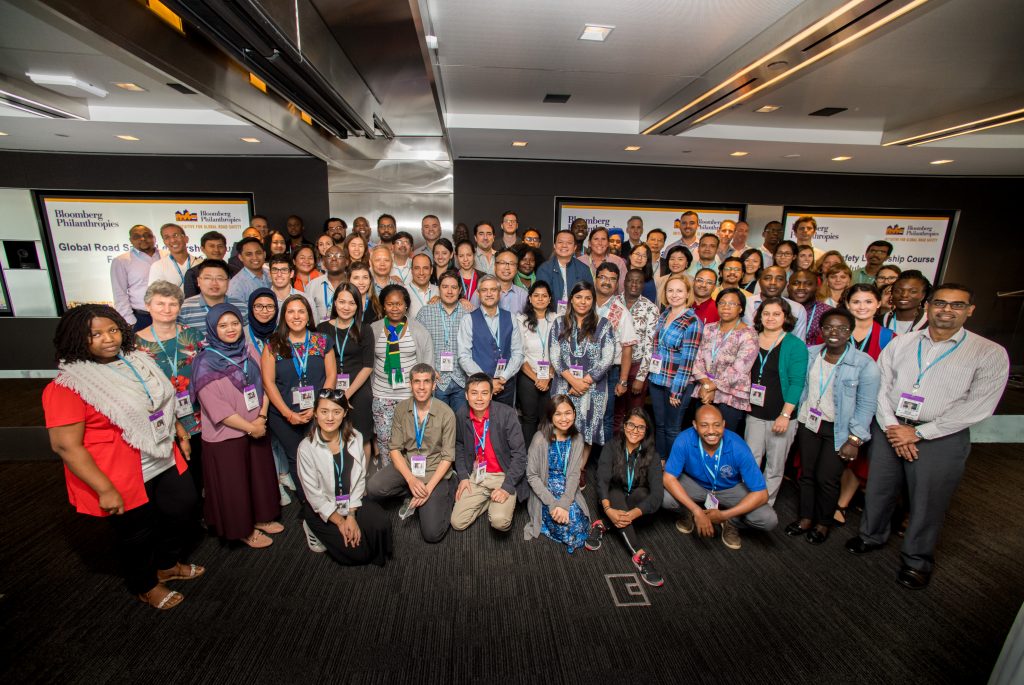Spreading Solutions: Lessons from the Global Road Safety Leadership Course

By Becky Bavinger, Bloomberg Philanthropies Public Health team
The Global Road Safety Leadership Course – a two-week course organized by Johns Hopkins University Bloomberg School of Public Health and the Global Road Safety Partnership – has trained over 300 people from 50 countries since 2016. Held twice each year – once in Baltimore and the other at a rotating location so far including Kuala Lampur, Malaysia and Nairobi, Kenya – the course is part of the Bloomberg Initiative for Global Road Safety which focuses on spreading effective road safety solutions and building capacity of municipalities to implement road safety interventions, and supports national governments in strengthening legislation.
During the two weeks, participants learn evidence-based solutions to prevent road crash fatalities and injuries, and develop leadership skills that can be applied through their work once they return home.
“As course organizers, we are thrilled to have another talented class of course participants visit Bloomberg Philanthropies to interact with their team. It’s a wonderful opportunity for these practitioners from 22 countries to apply their new road safety knowledge while on site visits around New York City.” – Abdulgafoor Bachani & Judy Fleiter
As part of the most recent course, the group traveled from Baltimore to New York on July 27th where Bloomberg Philanthropies hosted experts from various fields, including law enforcement, communications, road engineering, and data analysis. They learned directly from New York City’s Department of Transportation (DOT) and Police Department (NYPD) before venturing out to see first-hand how New York City streets are designed to be safer for pedestrians and bicyclists.
I had the opportunity to speak with participants about their takeaways from the New York City visit.
Daphne Kemunto spends her days focused on school children’s safety in Kenya. She is the Executive Director of Usalama Watch Initiative, which works with counties throughout Kenya to paint zebra crossings (broad white strips for pedestrian crossings), install speed bumps and rumble strips (raised strips along the road to reduce speed), and post speed limit signs around schools so children can safely walk to school each day. Daphne was moved by the presentation from Kim Wiley-Schwartz of the DOT who spoke about interventions like speed cameras near schools. Daphne said, “We were able to pass a law amendment to the traffic law (in Kenya), lowering the speed limits to 30 kilometers per hour (equivalent to 19 miles per hour) around schools. But even though we posted speed limit signs near schools, the enforcement is weak so drivers don’t abide by the limit. So we want to create a ‘model school’ with dedicated lanes for buses, bicycle lanes, and bollards (short posts to guide traffic), and collect metrics before and after to show that these kinds of road engineering changes can prevent crashes and save lives.” Daphne also loved the concept of helping victim’s families to form an association that could advocate for road safety interventions and hopes to establish this type of group in Kenya.
Amitesh Kumar had a different take-away. Mr. Kumar is the Joint Commissioner for Police in Mumbai, and highlighted the use of data that both DOT and NYPD employ in planning their interventions. “With data-driven enforcement, I can use the resources of our police department more effectively and zero in on the target audience. We need to take enforcement up to a certain level to change road users’ perceptions and behavior; only then it can decrease.” Mr. Kumar also noted that many challenges facing NYC are also present in Mumbai, such as the demand for space on Mumbai’s streets by pedestrians, bicyclists, and vehicles. But he left with a positive message, “After this course I can go home and present to the political leadership in Mumbai equipped with better data from other cities that road safety is worth investment.” Based on the DOT example of collaborating with our professional baseball teams to increase fan awareness of road safety, Amitesh hopes to find a partnership with one of the cricket teams in India to help amplify the road safety message.
Dr. Judy Fleiter of the Global Road Safety Partnership and Dr. Abdul Bachani of Johns Hopkins University Bloomberg School of Public Health are co-organizers of the course, and reflected on the visit saying, “The wealth of knowledge available here in New York City is invaluable for our course participants. And with support from Bloomberg Philanthropies, we’re able to build capacity among our fifth group of Global Road Safety Leadership Course participants to provide them with the skills to design, advocate for, and implement effective road safety programs and policies.”
Indeed, the most encouraging thing overheard throughout the day was course participants applying the knowledge learned from their coursework to what they were seeing in NYC, and bringing in examples from their own cities. The alumni of this course stay connected once they return home, and through this network they will continue to share lessons with each other.